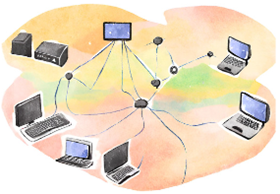Event logs are our breakfast, lunch, and dinner at NXLog. Before NXLog, I worked on an API that collected software usage logs. And before that, on a centralized log management application. Today, after a career of dealing with logs, I wondered, "How did our world come to rely so much on event logging?"
I mean, in the vast landscape of technological progress, the history of event logging is only a minor subplot. But when you think about it, event logs play a significant role in running and securing our digital world. So, I decided to journey back in time to discover what prompted our ancestors to start logging events and how this evolved into the elaborate logging systems we love today.
The genesis of event logging

The concept of logging events has its roots in ancient human societies. Early civilizations relied on manual entry systems to keep records of important events. For instance, in ancient Mesopotamia, people used clay tablets to document transactions and events such as births, deaths, and battles, providing an early form of event logging.
As societies progressed, so did their recording-keeping systems. The ancient Egyptians, Greeks, and Romans went on to introduce more structured methods. Stone inscriptions, parchment, and early forms of paper were all mediums for documenting events and transactions. Humans were indeed determined to log events they might need to refer back to.
Manual logging systems

Fast forward to the medieval and Renaissance periods, and we witness the emergence of more advanced manual logging systems. Did you know that monasteries were known for their meticulous record-keeping practices? Detailed manuscripts documenting events from agricultural activities to significant societal changes were found from this period. These handwritten logs were the early predecessors to modern event logs.
The invention of the printing press in the 15th century revolutionized how information was recorded and distributed. Books, newspapers, and official documents marked a significant leap in logging efficiency. However, the process was still time-consuming and error-prone. It could not meet the demands of the rapidly evolving modern world.
The advent of digital logging

The 20th century brought about a paradigm shift in how we log events. Once businesses and organizations started embracing technology, more efficient and accurate record-keeping was required. The early computer systems of the mid-20th century laid the foundation for digital event logging.
Initially, computer logs recorded basic system errors and warnings. Then, with mainframe computers, the 1950s saw the introduction of logging mechanisms to aid in system diagnostics. Although primitive by today’s standards, these logs represented our departure from manual logging and, we can say, were the foundation of digital event logging.
The rise of operating system logs

With the proliferation of personal computers in the 1980s and 1990s, operating systems began incorporating more sophisticated logging mechanisms. Microsoft Windows, UNIX, and other operating systems started logging a broader range of events, such as user logins, application launches, and system startups and shutdowns. These logs were crucial for troubleshooting, security, and auditing and are still the base of every logging policy.
Simultaneously, the rise of the internet and networking technologies introduced new challenges. Besides operating system logs, we now needed to monitor and log network activity, which led to the development of network logging systems. Network devices like firewalls and routers started generating logs to help administrators track and analyze network traffic.
The security imperative: logging for threat detection

With the internet becoming more and more integrated into our lives, cyber threats have become more frequent, not to mention sophisticated. IT administrators needed to be more proactive. With their ability to record activities chronologically, event logs became instrumental in identifying and mitigating security incidents.
However, administrators also needed to efficiently manage and store the overwhelming amount of logs to make sense of them. Security Information and Event Management (SIEM) solutions emerged to centralize and analyze logs from all the different sources, providing a holistic logging and security view. Most modern SIEMs can automatically detect anomalous activities and take action on potential security breaches. This is where we see a shift in the role of event logs. From mere troubleshooting aids, they became key players in the fight against cybercrime.
Event logs as Business Intelligence

In the 21st century, the scope of logging has expanded beyond troubleshooting and security. In the era of business intelligence, logs are driving decision-making and strategic planning. From tracking user behavior and application usage patterns to analyzing performance metrics, business intelligence is everywhere, and those not using it are at a disadvantage.
Logs have also become integral to DevOps practices, facilitating continuous monitoring of complex software development environments and improving CI/CD processes. Logs help engineers identify bottlenecks to optimize their software development lifecycle—a must in today’s fast-paced software release cycles.
The present: Artificial Intelligence and beyond

So, here we are. In the contemporary digital landscape, Artificial Intelligence (AI) is revolutionizing the world as we know it. Just the same, AI is transforming event logging in unprecedented ways. The sheer volume and complexity of logs have become a real struggle. However, advanced AI algorithms are using this to their advantage.
Machine learning models can analyze massive datasets and detect patterns and anomalies, categorize and prioritize events, and trigger predefined actions to mitigate any impact, all in real time. The more data analyzed, the more accurate the predictions, and the more effective the response.
The scalability of AI allows us to manage logs effectively, streamline log analysis, and implement proactive, refined defense against cybersecurity threats. In an age where attackers target anything and everything, from sabotaging Taylor Swift’s Eras Tour ticket sale and disgruntling millions of fans to compromising the Colonial Pipeline and disrupting the gas supply in the U.S.—we need all the help we can get.
Conclusion
From this little expedition, I confirmed that event logging is human nature. With the digital revolution, event logs have become the backbone of IT infrastructure. Maintaining efficient logging practices is critical for us in IT and DevOps, and we must embrace the tools (I glance towards AI here) that help us navigate the complex world of event logging. I am excited to see how event logging will develop in the coming years and what new challenges the continuously evolving digital landscape will bring. Remember, all these advanced AI systems need to be monitored, too. But that’s a topic for another day!

